Found a total of 10000 related content

How to implement a thread-safe singleton pattern in Java?
Article Introduction:There are three main ways to implement thread-safe singleton mode: First, use double check lock and volatile keywords, enter the synchronization block after the first check that the instance is empty, and confirm again whether it is empty, ensuring that only one instance is created; second, use static inner class (BillPugh implementation) to ensure thread safety during class loading through JVM, delay loading and no explicit synchronization is required; third, use enumeration to implement singleton, which is naturally thread-safe and can prevent reflection and serialization attacks, but may not be suitable for complex initialization or inheritance. In addition, the simple lazy style affects performance because each call needs to be synchronized, and is not recommended to use in a multi-threaded environment. Choose different implementation methods according to your needs to take into account security, performance and simplicity
2025-07-13
comment 0
488

Mastering C# .NET Design Patterns: From Singleton to Dependency Injection
Article Introduction:Design patterns in C#.NET include Singleton patterns and dependency injection. 1.Singleton mode ensures that there is only one instance of the class, which is suitable for scenarios where global access points are required, but attention should be paid to thread safety and abuse issues. 2. Dependency injection improves code flexibility and testability by injecting dependencies. It is often used for constructor injection, but it is necessary to avoid excessive use to increase complexity.
2025-05-09
comment 0
1023
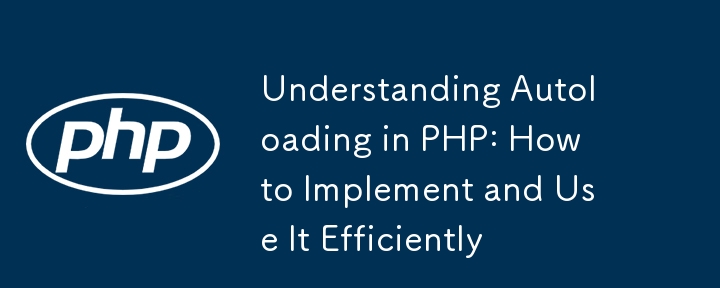
Understanding Autoloading in PHP: How to Implement and Use It Efficiently
Article Introduction:Autoloading in PHP: Concept and Implementation
Autoloading is a mechanism in PHP that automatically loads classes when they are needed, without requiring an explicit include or require statement for each class file. It helps streamline code org
2025-01-01
comment 0
687

Understanding Dependency Injection in Laravel?
Article Introduction:Dependency injection automatically handles class dependencies through service containers in Laravel without manual new objects. Its core is constructor injection and method injection, such as automatically passing in the Request instance in the controller. Laravel parses dependencies through type prompts and recursively creates the required objects. The binding interface and implementation can be used by the service provider to use the bind method, or singleton to bind a singleton. When using it, you need to ensure type prompts, avoid constructor complications, use context bindings with caution, and understand automatic parsing rules. Mastering these can improve code flexibility and maintenance.
2025-07-05
comment 0
1044

What is the Factory pattern?
Article Introduction:Factory mode is used to encapsulate object creation logic, making the code more flexible, easy to maintain, and loosely coupled. The core answer is: by centrally managing object creation logic, hiding implementation details, and supporting the creation of multiple related objects. The specific description is as follows: the factory mode handes object creation to a special factory class or method for processing, avoiding the use of newClass() directly; it is suitable for scenarios where multiple types of related objects are created, creation logic may change, and implementation details need to be hidden; for example, in the payment processor, Stripe, PayPal and other instances are created through factories; its implementation includes the object returned by the factory class based on input parameters, and all objects realize a common interface; common variants include simple factories, factory methods and abstract factories, which are suitable for different complexities.
2025-06-24
comment 0
424
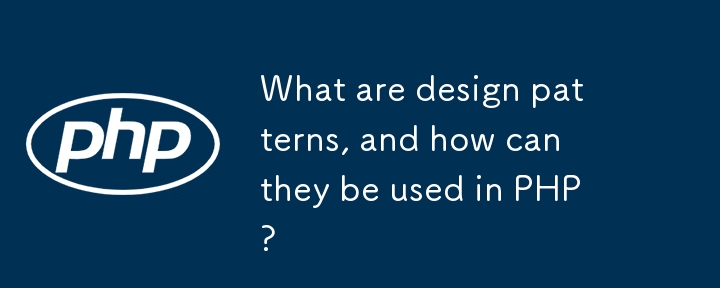
What are design patterns, and how can they be used in PHP?
Article Introduction:Common applications of design patterns in PHP include Singleton, Factory, Observer, and Strategy. They are reusable templates to solve duplication problems, not code that is directly copied. Use scenarios include code duplication, project size expansion, improved testability and reduced dependency. The application steps are: first understand the problem, then select the appropriate mode, keep it simple to implement, and can be reconstructed and optimized later. For example, Factory mode can be used to return different database instances based on configuration, thereby simplifying maintenance.
2025-06-23
comment 0
747
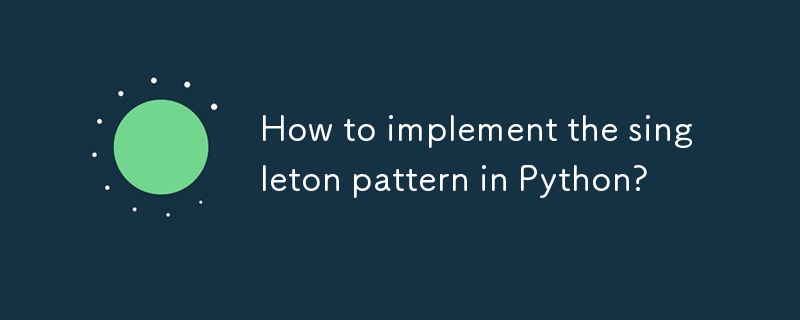
How to implement the singleton pattern in Python?
Article Introduction:There are three main ways to implement Singleton mode in Python: 1. Use a decorator to control the creation and reuse of class instances by defining closure functions. The advantages are that the code is clear and reusable, but the debugging is not intuitive enough; 2. Rewrite the \_\_new\_\_ method to maintain the instances within the class. The advantages are more native and object-oriented, but pay attention to multi-threaded safety issues; 3. Use the natural singleton characteristics of the module to directly create instances in the module and export and use them, which is simple and easy to maintain but poor flexibility. Choose the appropriate method according to actual needs: flexibly control the selection of decorators, object-oriented selection of \_\_new\_\_, and use the modules simply globally.
2025-07-14
comment 0
314

How does dependency injection improve code testability and maintainability in PHP?
Article Introduction:Dependency injection (DI) makes PHP code easier to test and maintain by reducing tight coupling between components. Its core advantages include: 1. Simplify unit testing, allowing injection of simulated objects to replace real services, avoid side effects, and improve testing speed and reliability; 2. Promote loose coupling, making the class dependency interface rather than concrete implementation, making it easier to independently modify and expand components; 3. Improve reusability and configuration flexibility. The same class can achieve diversified behavior by injecting different dependencies in different contexts, such as the development, production and testing environments using different logging methods. In addition, modern PHP frameworks such as Symfony and Laravel built-in DI containers further simplify the implementation of object management and dependency injection.
2025-06-04
comment 0
525
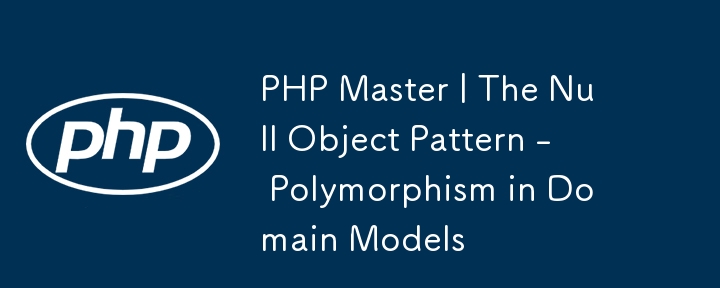
PHP Master | The Null Object Pattern - Polymorphism in Domain Models
Article Introduction:Core points
The empty object pattern is a design pattern that uses polymorphism to reduce conditional code, making the code more concise and easy to maintain. It provides a non-functional object that can replace the real object, thus eliminating the need for null value checks.
Empty object mode can be used in conjunction with other design modes, such as factory mode creating and returning empty objects, or policy mode changing the behavior of an object at runtime.
The potential disadvantage of the empty object pattern is that it may lead to the creation of unnecessary objects and increase memory usage. It may also make the code more complicated because additional classes and interfaces are required.
To implement the empty object pattern, you need to create an empty object class that implements the same interface as the real object. This empty object provides a default implementation for all methods in the interface, allowing it to replace the real object. This makes
2025-02-25
comment 0
631

How to Implement Dependency Injection in PHP
Article Introduction:Implementing dependency injection (DI) in PHP can be done by manual injection or using DI containers. 1) Manual injection passes dependencies through constructors, such as the UserService class injecting Logger. 2) Use DI containers to automatically manage dependencies, such as the Container class to manage Logger and UserService. Implementing DI can improve code flexibility and testability, but you need to pay attention to traps such as overinjection and service locator anti-mode.
2025-05-07
comment 0
1149

PHP Master | Logging with PSR-3 to Improve Reusability
Article Introduction:Core points
PSR-3, a common log object interface, allows developers to write reusable code without relying on any specific log implementation, thereby improving compatibility between different log libraries in PHP.
The PSR-3 interface provides eight methods to handle messages of different severity levels, and a common log() method that can receive any severity levels. Its design is to solve the problem of log implementation incompatibility.
Although PSR-3 has many benefits, some log libraries do not support it natively. However, developers can create PSR-3 compliant adapters by leveraging the adapter pattern and extending the AbstractLogger class provided in the Psr/Log library.
Many major PHP projects
2025-02-24
comment 0
1246
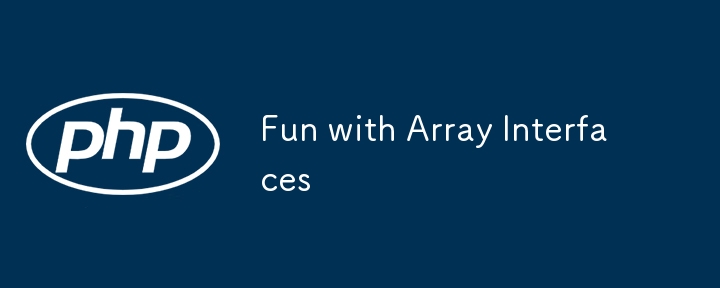
Fun with Array Interfaces
Article Introduction:Key Points
PHP's array interface allows programmers to simulate the characteristics of native data types in custom classes, similar to Python's methods. This enables custom classes to work like arrays and allows common array operations such as counting elements, looping through elements, and accessing elements through indexes.
An interface is like a contract for a class, specifying the methods that a class must contain. They allow encapsulation of implementation details and provide syntax sugar, thereby improving the readability and maintainability of the code. PHP provides a library of predefined interfaces that can implement these interfaces to make objects similar to arrays.
Countable, ArrayAccess and Iterator interfaces in PHP allow objects to pass cou respectively
2025-02-22
comment 0
510

How to implement hook function in PHP?
Article Introduction:Implementing hook functions in PHP can be implemented through observer mode or event-driven programming. The specific steps are as follows: 1. Create a HookManager class to register and trigger hooks. 2. Use the registerHook method to register the hook and trigger the hook by the triggerHook method when needed. Hook functions can improve the scalability and flexibility of the code, but pay attention to performance overhead and debugging complexity.
2025-05-15
comment 0
303
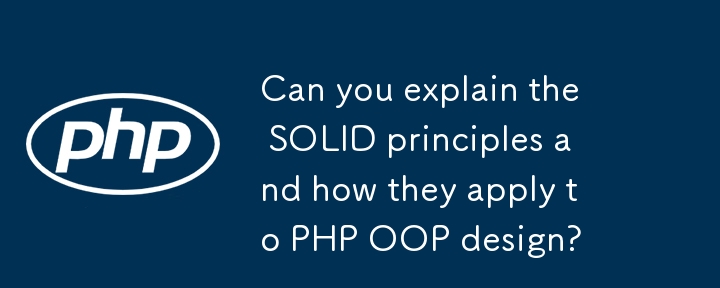
Can you explain the SOLID principles and how they apply to PHP OOP design?
Article Introduction:SOLID principle improves code maintainability and scalability through five core principles in PHP object-oriented design. 1. The single responsibility principle (SRP) requires that each class has only one responsibility, and the separation of concerns is achieved through splitting functions; 2. The opening and closing principle (OCP) advocates extending behavior through interfaces or combinations rather than modifying the original code; 3. The Richter replacement principle (LSP) ensures that subclasses can replace the parent class without destroying logic and avoid behavior inconsistencies; 4. The interface isolation principle (ISP) recommends defining fine-grained interfaces to avoid redundant dependencies; 5. The dependency inversion principle (DIP) decoupling high-level and underlying modules by relying on abstract types (such as interfaces) rather than concrete implementation, and is commonly implemented by dependency injection.
2025-06-19
comment 0
634

Deep dive into the Laravel Service Container and Dependency Injection
Article Introduction:Laravel's service container is a core tool for managing class dependencies and executing dependency injection. It simplifies code development and maintenance by automatically instantiating objects and their recursive dependencies. 1. The service container is like a "factory" that can automatically create and pass the required objects; 2. Support constructor injection (most commonly used), method injection (used in the controller type prompt), and setter injection (suitable for optional dependencies); 3. The binding methods include simple binding, singleton binding, and interface binding implementation classes to achieve decoupling; 4. In most cases, the container automatically resolves dependencies, and can also manually obtain instances through app() or make(); 5. Alias ??can be set for the binding and the binding is registered by the service provider to improve the application organizational structure and maintainability.
2025-07-03
comment 0
883
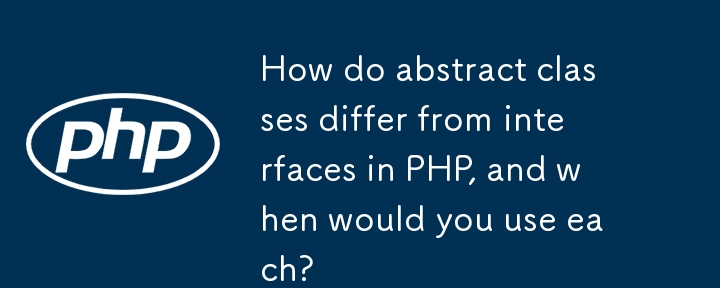
How do abstract classes differ from interfaces in PHP, and when would you use each?
Article Introduction:Abstract classes and interfaces have their own uses in PHP. 1. Abstract classes are used to share code, support constructors and control access, and include abstract methods and concrete methods. 2. The interface is used to define behavior contracts. All methods must be implemented and are public by default, and support multiple inheritance. 3. Since PHP8, the interface can contain default methods to implement, but there is still no constructor or state. 4. When using abstract classes, you need to encapsulate implementation details; when using interfaces, you need to define cross-class behavior or build plug-in systems. 5. Can be used in combination: abstract classes implement interfaces or combine multiple interfaces into one abstract class. Select whether the structure plus sharing behavior (abstract class) or only the structure (interface).
2025-06-04
comment 0
1108
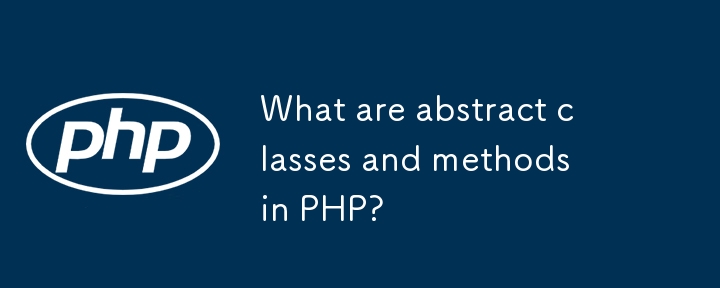
What are abstract classes and methods in PHP?
Article Introduction:Abstract classes and methods are used in PHP to build object-oriented programming structures that define the blueprints that other classes must follow. Abstract classes cannot be instantiated directly, they can only be inherited, and can contain ordinary methods and abstract methods; abstract methods only define method names and parameters, and there is no concrete implementation. Subclasses must implement all abstract methods. Use abstract classes to force consistency, avoid duplicate code and optimize design. For example, the payment method class can define an abstract process() method, and different payment types can be implemented on demand. Key rules include: classes containing abstract methods must be declared as abstract classes, abstract classes cannot coexist with finals, and interfaces are stricter and have no implementation.
2025-06-20
comment 0
424

PHP: Writing Multi-Line Code Comments
Article Introduction:PHP multi-line comments use // wrap content, suitable for explanation logic or blocked code; it is recommended that PHPDoc style be used for function and class comments to improve IDE recognition and development efficiency; comments should be clear and useful, avoid redundancy, and focus on explaining the reasons for implementation rather than the operation itself. For example: / comment content/or /*PHPDoc comments/defines function parameters and return values, and pay attention to closing symbols to avoid syntax errors. Good comments need to be combined with context to help understand complex logic or special handling methods.
2025-07-16
comment 0
208


Dave The Diver: How To Catch Spider Crabs
Article Introduction:In Dave The Diver, there are some creatures that are not easy to catch. Or, catch alive that is. The spider crab is one of those very species, making it seem like the only way to bring these crustaceans back up to land is to viciously crack them up w
2025-01-10
comment 0
800



















